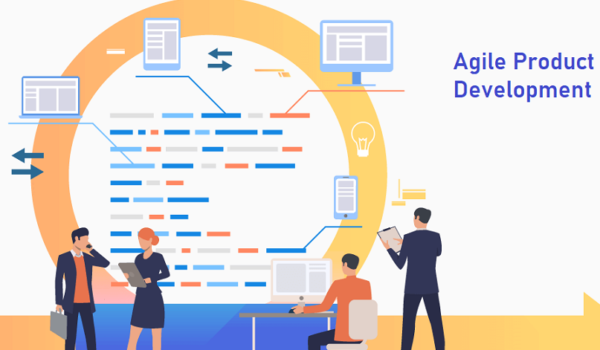The Agile model has taken the testing and software development world by storm, providing the best range of software solutions, mobile apps, and websites. In fact, due to its functionality and success, almost 85.9% of software developers have started using this development methodology.
One of the branches of this model is the Agile Product Development branch. It is constructive for companies and rapidly incorporated in organizations to help them develop the best products for their clients. Wish to know more about Agile product development security and its essential aspects? Continue reading as we uncover the different aspects of this methodology.
What is Agile Product Development?

Agile product development refers to creating different products with the help of Agile’s different techniques and processes. This can be related to hardware, software, or both. This development allows other companies and organizations to develop their products to respond to any uncertainty, risk, or range without any hassle.
The Agile product development model requires self-organizing teams to help create faster, better prototypes by constant and open communication with customers. The project managers and customers then review these developed prototypes repeatedly to find any security issues and provide valuable feedback before the final product.
Organisations usually incorporate Agile product development into software or Mobile app development, but they use it in other development activities due to its success. According to studies, almost 60% of organizations that incorporate Agile have experienced considerable profit growth!
Agile has 12 main principles and a set of practices and frameworks like Kanban and Scrum, allowing development teams to create and innovate products that their customers require. This model easily blends in with new market changes and technologies, thus providing various working opportunities.
But the question arises – how does Agile product development deal with security and whether it is safe to use for organizations. Let’s take a look.
How Does It Deal with Product Development Security?
The main motive of dealing with security issues by identifying, analyzing, and solving them is doing it all with 100% accuracy and speed. And Agile ensures that it can help you deal with security issues by providing effective solutions for your problems as soon as possible.
Here is how Agile deals with product development security –
Responds to Change
Agile product development responds to change by providing a list of essential items to work on from every project. This allows stakeholders to reflect on any possible changes in the market, customers getting solutions to every problem they might face, and your developers getting to work on various aspects, allowing them to develop solutions for every possible situation. Agile’s response to change ensures that security problems get detected early on, providing better solutions as and when required.
Accepts Uncertainty
Agile’s product development model accepts that there will be uncertainty and security issues as one starts working on a particular problem. It works around this knowledge that it will uncover more details about different technical solutions or will discover more security issues with the solutions that a developer comes up with. This Agile principle is crucial for organizations to accept that there will be uncertainty. Thus, it will allow them to be prepared for security problems that might occur, helping them identify and eradicate them on the way.
Today, much application development and testing is done in the cloud environment — on various IaaS and PaaS environments. You need to be mindful of the concept of “shared responsibility” in the context of public cloud security. This is part and parcel of the Agile model.
Better Review Cycles
Rapid iteration and cyclical, complete assessments as work is finished are required for teams to be both accepting of uncertainty and responsive to change. This ensures that every discovery is considered and present efforts are appraised. Customers or stakeholders, or project managers are then consulted about the efforts. The emphasis on obtaining timely reviews and input from actual users allows them to use the product directly and see how it works and whether it can directly eliminate their security problems.
Great Flexibility
Agile’s product development model is extremely flexible. How? Well, in addition to the better review cycles provided for developers and customers, it provides the organization itself a lot of flexibility during product delivery thanks to the effort-boxed and time-boxed iterations of work. This ensures sufficient functionality that is otherwise lacking in traditional approaches that believe in the release on particular end dates without sparing much thought to the efficiency of the actual end product.
Lesser Up-front Work
Agile product development mostly focuses on prioritizing and defining various security problems to solve. This is done with the collaboration of developers to help design and revise what needs to be done while exerting just the sufficient amount required to take the project or product to its next phase. This significantly decreased up-front work and costs which were otherwise incurred due to excess investigation and documentation.
However, two main security problems are being faced by those using the Agile model. They are –
Not enough security user stories
One major problem faced by Agile product development is the lack of strong security user stories. This halts the agency from planning and implementing security measures beforehand.
Not enough Agile-ready tools and practices for security
In the Agile model, one’s business requirements need to sync with the model’s security processes and requirements. This cannot be done by the model itself – the organization’s development teams need to complete this process. However, most organizations are unable to do this on time leading to security issues.
In order to integrate better security into Agile product development, you need to incorporate additional mechanisms into your development methods. The answer is SecDevOps — the emerging set of best practices designed to help programmers and software architects implant security into their DevOps development and deployment processes.
You can bridge the gap between security and Agility by:
- Keeping application security in mind at all times during development
- Justifying the security demands by defining precise acceptance criteria
- Dealing with security issues with your team as a group
- Reflecting on past security incidents and approaches to develop new procedures
If you cannot think of any quick mechanisms and practices to follow, here are some security practices you can follow in Agile product development to better deal with security issues…
Security Practices in Agile Product Development
Define security and vulnerability with risk sessions
Your stakeholders or project managers and your team should be allowed to communicate as much as possible regarding what they want to be done and to decide how to do it. This can be recorded in risk sessions in the definition of done or DoD to help you remember all the problems that need to be fixed before the software completion. This practice will help you to take Agile product development security seriously and to work on it from the very beginning.
Allow stakeholders to get security checks during product reviews
During demos or product reviews, when you and your team present the product, make sure to ask for your stakeholder or your project manager’s opinion. This will give them the satisfaction of using the software once to ensure it works effectively and whether this is what they are looking for.
Use acceptance criteria to check the security of certain user stories
Acceptance criteria will help you and your team formulate your security requirements, what type of measures, and how many security measures are required. This advanced spotting and defining of security aspects will give your team ample time to develop better software to meet all security demands, all before delivery!
Use Agile Retrospective
The Agile retrospective is a handy feature included by the Agile team. This feature will allow your team to review their work time and again to help them improve themselves as and when required. This retrospective feature lets you determine any recurring or significant security issues and their primary cause. This will allow you to solve security problems as soon as possible, saving you from considerable security problems later.
Work as a group
If your security has been compromised, the best way to deal with it is to discuss it with your team as a group. This will help you to brainstorm faster, coming up with practical solutions quickly for damage control. When your team members from various fields come together to solve one problem, you will get different suggestions, leading to the growth of updated software to avoid further trouble. You can even include some of your stakeholders like project or product managers to give you valuable insight.
Conclusion
Security in Agile product development still has a long way to go. As the Agile software is slowly getting incorporated into various organizations, newer, better security practices are coming up to ensure better working. So make sure your problems have been identified, your team has sufficient security knowledge and valuable tools to work with, and you are good to go! Best of luck! All you have to do is understand your security problems and figure out a set of practices that help you improve Agile product development and security.
Check out all the software testing webinars and eBooks here on EuroSTARHuddle.com
About the Author

Ankit Thakor is a marketer by trade and a football player by passion. He is a Saas Marketing Specialist at SoftwareWorld. He specializes in using compelling content to capture consumer dollars for world-class SaaS brands, including Zoho, Freshworks, ClickUp, and more. You can follow him on Twitter, LinkedIn and Quora.